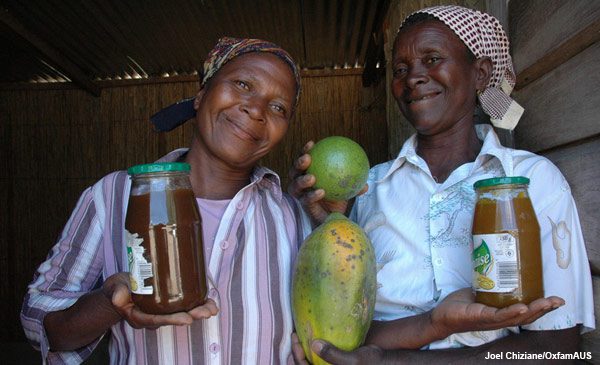
We hope you’ve been enjoying our stories from Mozambique, told by real people we’re working with to fight hunger in the face of a challenging new climate.
Today we introduce you to Rosa Domingos Zita and Marta Cossa, from Mabawane in Gaza Province. Oxfam News editor Maureen Bathgate travelled to Mabawane to talk to Rosa and Marta about the food processing techniques they’re learning from our local partner, the Association for the Development of Rural Communities (ADCR) to make their harvests last longer.
Where did you learn how do to do food processing?
Rosa: ADCR taught us food processing.
Can you talk me through the various products?
Rosa: This is tomato jam. We boil the tomatoes first and we peel them; we take out the seeds; then we mash them up; then we put sugar in — three cups of jam to two teaspoons of sugar. Then we put it in the pot to with water and boil it for 10 minutes.
How would you use tomato jam?
Rosa: We put it on bread. Before, we used to grow a lot of tomatoes, but we didn’t know we could use them to make jam. We used to lose a lot of tomatoes because they would all ripen at the same time and we would have too many too eat and they would rot. This is a way to make them last longer.
Marta: This is sweet potato juice. It’s almost the same process. We wash the sweet potatoes and we boil them. After cooking, we peel them and grind them using a sieve. We then add sugar and water.
It’s a different way to use sweet potatoes. We didn’t know how to do this before. We just cooked them and ate them; we didn’t know we could make juice out of them.
Rosa: These are preserved vegetables. This is cabbage, carrots, green beans, garlic, chillies and green pepper. We boil them first, then cut them, slice them and then put them in vinegar. Besides the vinegar, we put in two teaspoons of sugar and one teaspoon of salt. That helps to keep them from spoiling. They can last up to a year.
How would you use these vegetables?
Rosa: We can eat them as is with rice, or mix them into curries as one of the ingredients.
This is White Masala jam. We wait until the masala falls down, and take it to wash, break it and take out the seeds. Then grind it to make a pulp. The jars should be boiled in water. We put in one cup of sugar for five masalas.
We are not sure how long it takes to cook. It depends on the water. When the water disappears, you know it has been cooked and is ready. You have to watch the water.
With the papaya jam, it is the same process as masala.
This is carrot juice. We take a carrot, wash it, grate it, peel it, and cook it. Then we grind it and cook it again. We put three cups of carrots with two cups of sugar. We then put in three litres of water and then it’s ready.
What is the biggest advantage of using the food this way?
Marta: The biggest advantage of processing food like this is before we used to lose what food we had produced because it rotted before we could eat it all. We didn’t know how to keep it. Now we have this way of keeping it. We learned techniques to increase our harvest and grow more food, but we couldn’t eat all of it before it spoiled.
Do you use these food processing techniques at home?
Rosa: Yes I do use these techniques at home with my family. Our children like eating them because they are not new foods, they are just a new way of preparing what we have been eating for a long time.
Next week, meet Rosa and Marta’s neighbor Maria and hear how some simple gardening techniques have vastly increased the amount of food she can grow.
(Want to help make a difference? Donate to our Stop Hunger appeal and support our work with poor communities in Mozambique.)